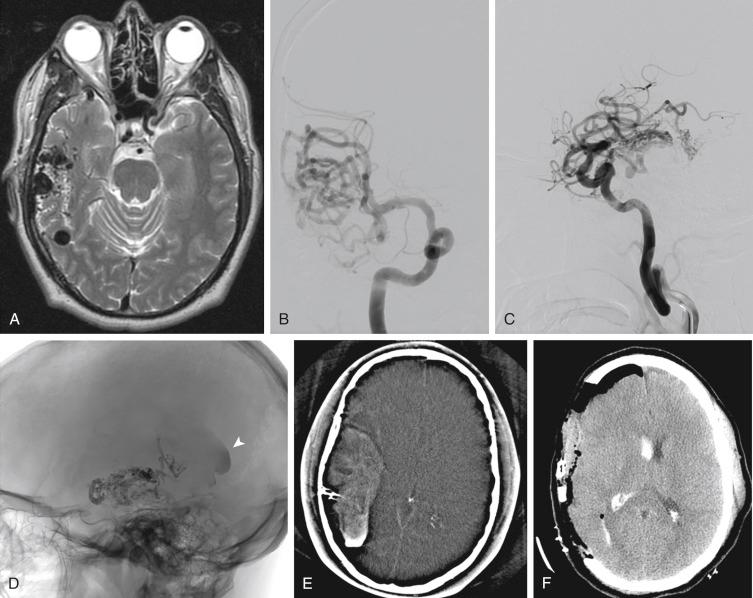Physical Address
304 North Cardinal St.
Dorchester Center, MA 02124
A healthy, 41-year-old man presented to his primary care physician with a 3-month history of right-sided temporal-occipital headaches. He was initially treated conservatively with oral analgesics and subsequently an occipital nerve block without significant improvement. Magnetic resonance imaging (MRI) was eventually obtained demonstrating the presence of a 2 × 3 cm arteriovenous malformation (AVM) located in the right temporal lobe ( Fig. 37.1 ). After neurosurgical consultation, a catheter cerebral angiogram was obtained confirming the presence of a Spetzler-Martin Grade III AVM ( Table 37.1 ). The AVM was fed by middle cerebral artery and posterior cerebral artery branches and had drainage by both superficial Sylvian veins and the vein of Labbé to the transverse-sigmoid sinus junction.

| Points | |
|---|---|
| Size | |
| Less than 3 cm | 1 |
| 3–6 cm | 2 |
| Greater than 6 cm | 3 |
| Location | |
| Not eloquent | 0 |
| Eloquent | 1 |
| Venous Drainage | |
| Superficial | 0 |
| Deep | 1 |
Treatment options including radiosurgery, embolization, surgical resection, and conservative management were discussed with the patient. He was counseled that radiosurgery would not diminish the risk of hemorrhage during the 2- to 3-year delay to treatment effect. Furthermore, although the cure rate after radiosurgery is good (70%–80%), it was not guaranteed. He was told that embolization alone could not cure the AVM but would be an excellent adjunct before surgical resection. He was also told that the prognosis for headache resolution was good once the AVM was cured. The patient elected to undergo staged preoperative embolization followed by craniotomy for resection of the AVM.
The patient was electively brought to the neuroendovascular suite where his baseline blood pressure after arterial line placement was 130/70 mm Hg. General endotracheal anesthesia was induced. The femoral artery was cannulated and embolization of the AVM commenced with the use of N -butyl cyanoacrylate (NBCA) glue. Near the end of the uneventful procedure, it was noted that significant contrast extravasation was present adjacent to the AVM (see Fig. 37.1 ). His systolic blood pressure suddenly became elevated to 170 mm Hg. DynaCT rotational angiography confirmed the presence of a large hemorrhage with mass effect adjacent to the AVM. The patient was immediately taken to the operating room where hemicraniectomy as well as intracerebral hemorrhage (ICH) evacuation and AVM resection were performed. Postoperative catheter cerebral angiogram demonstrated no residual arteriovenous shunting.
The patient was taken to the neurologic intensive care unit (ICU) where he was slowly woken up and his systolic blood pressure was maintained between 90 and 120 mm Hg using a nicardipine infusion. He was extubated the following morning and noted to have a mild left-sided hemiparesis and superior quadrantanopsia. The patient was eventually discharged to an acute rehabilitation facility and made a full recovery.
Become a Clinical Tree membership for Full access and enjoy Unlimited articles
If you are a member. Log in here